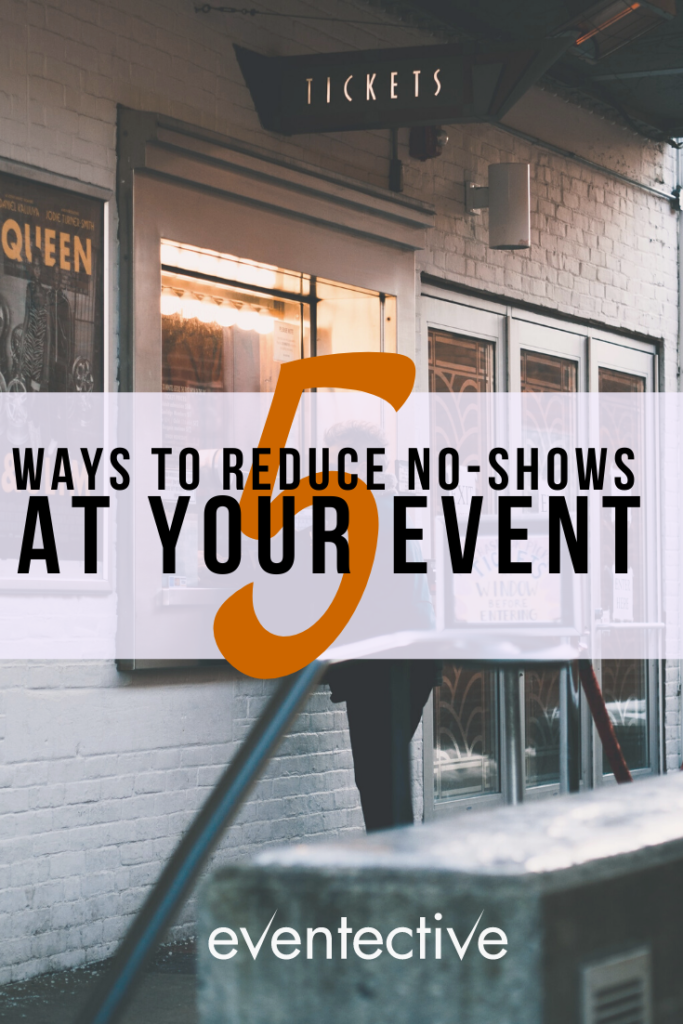
Your events are important to your business and your audience. We know that and you know that. Some of your audience even knows that, too! That’s why they show up to your events. But sometimes it can feel like not enough people know how important your events are, especially when the no-show rates are high. As a result, you may be tempted to overhaul your approach to events. And while we wouldn’t necessarily stop you (because sometimes an overhaul is needed), we would recommend that you try these five smaller scale ways to reduce no-shows.
As the name so clearly states, no-shows are people who don’t show up to events. In the context of this post, we’re talking specifically about attendees who say they will attend, and then don’t. Maybe they registered for a free ticket or simply checked attending on the online event. It doesn’t matter how they signed up; all that matters is that they signed up, and then didn’t come.
It’s highly unlikely that you’re event will ever have zero no-shows. After all, life happens. Cars break down, people get sick, and work schedules shift. But high no-show rates can impact your event revenue and take spots away from attendees who really want to be there. So, as an event planner, the goal is to reduce no-shows as much as possible. Average no-show rates vary by location and industry, so it’s important to generate your own data for your events and work on improving that over time with these five tips.
1. Offer Paid Ticket Options

Many virtual events are free to attend, and there’s merit behind that decision. For starters, a free event is more accessible to more people. Because the event isn’t guarded by a cost, anyone with the means to view the event can do so. But free events do have a history of no-shows. It’s easy to register for a free event and forget it or skip it, because you haven’t made any sort of investment into the event.
So if you’re planning a free event but still want to reduce no-shows, consider adding a paid ticket option. Even a small price tag increases the perceived value of your event and holds attendees a little more accountable to attend. Of course, if you offer a paid ticket option, you have to give attendees something in return. This could include a breakout session with the main speaker or early bird access to vendors—any extra-special moment that’s relevant to your event and your audience.
2. Stay In Touch
After your attendees register, don’t neglect them until the event week. Stay in touch with them until after the event. (Follow-up emails are great for securing repeat attendees.) This certainly can, and should, include email communication. But it can also include updates on social media and text messages, if your attendees choose. Creating an event hub on Facebook or another online platform will give your attendees somewhere to find information and will give you somewhere to put information.
Bonus Tip: Don’t forget to tell attendees how to contact YOU if they have questions or need help.
While social media is great for virtual communication, don’t let it replace emailing. After registration, attendees should receive an immediate confirmation email with the details of their purchase (if applicable) and the event as a whole. This includes instructions for accessing the event platform, more details on any speakers or talent, and instructions for checking in on the day of. Then, you should continue to email your attendees every 7-14 days to stay top of mind.
3. Create Incentives

If you want to reduce no-shows, you have to give your attendees a reason to show up! That may sound simple, but hosting your event isn’t necessarily enough of an incentive. As you plan the event, think about something you can give your attendees that no one else can. This can include access to an in-demand speaker or entertainer. But it can also include giveaways and freebies during your event.
To help choose the perfect incentives, ask yourself what your target audience really wants—and try to give it to them. Is there an author they’d love a live Q&A with? Maybe you’re launching a brand new product and you have samples to give out. Whatever will attract your attendees, don’t forget to tell your audience ahead of time! Market your exclusive offers to attract more registrants—and ensure that they’ll come.
4. Form a Waitlist
If your event is selling out quickly but there’s still buzz around it, start a waitlist. That way, as some registrations are canceled, you’ll have new registrations to back fill. This accomplishes two things. First, it reduces no-shows at your event. When an attendee cancels their registration, they’re not going to attend the event, which affects overall attendance. But when you have a waitlist, those empty seats can easily be filled.
Second, a waitlist creates a sense of exclusively for those who are on it. That build-up of excitement will make your event that much more exciting. Plus, if a spot does open up, those on the waitlist will be more likely to attend because they’ve been waiting so long to go.
5. Make Cancellations Easy

Yes, we know that this sounds counter-intuitive, but it’s true! When it’s easy for guests to cancel and refund their tickets, it’s easy to move someone off of the waitlist. Even if you don’t have a waitlist, cancelling a ticket means that that spot can open up for someone else to come. This will keep attendance numbers high and reduce no-shows.
Whatever your cancellation policy, be sure to clearly communicate it to your guests. You should post all the details on the website where tickets are purchased, in your confirmation email, and in follow-up emails as well. Remember: The goal is to make it easy!
Conclusion
Unfortunately, there’s no one magic way to reduce no-shows. You will likely have to implement a few of these tips at a time to see real results. But all of these ideas are completely customizable to your business, and you can fine tune them in whatever way is necessary. That may mean a little more work up front, but it will also result in improvement specific to your company needs. Happy planning!
Do you know what your no-show rate is? Which of these tools will you implement to reduce it?

